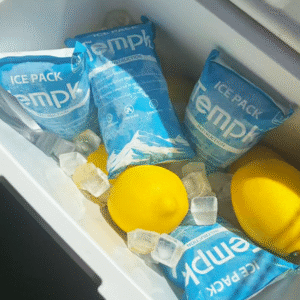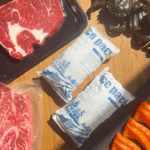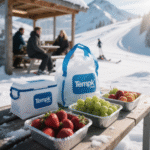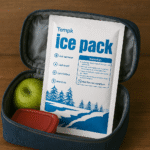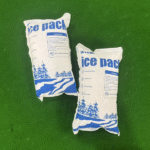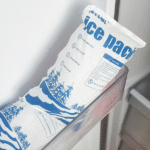Cobertor de embalagem de gelo seco: 2025 Guia de envio congelado
Intro — answer first: Se você precisar de confiabilidade congelada sem energia sem refrigeração alimentada, um cobertor de embalagem de gelo seco gives you deep-freeze capacity, margin for delays, and clean handoffs. Plan roughly 5–10 lb of dry ice per day and keep packages vented; aircraft packages may not exceed 200 kg de gelo seco. You’ll see where it beats gel or PCM, how to size it fast, and how to pass PI 954 cheques.
-
How a cobertor de embalagem de gelo seco works for −20 °C to −80 °C lanes and when it outperforms gel/PCM
-
Simple sizing rules (5–10 lb/dia) and a quick self-check for hot lanes and thin insulation
-
Como embalar, ventilação, and label for UN1845 and PI 954 acceptance—without overcomplicating SOPs
-
A comparison with gel sheets and sub-zero PCMs so you choose the right build for each route
-
2025 Atualizações: IATA 66th edition highlights, eAWB momentum, and CO₂ supply watch
What is a dry ice pack blanket—and when should you use it?
Use a dry ice pack blanket whenever frozen failure is unacceptable or transit time is uncertain. It creates a continuous “roof” of dry ice above your payload, holding freezer-level cold (as low as −78.5 °C) far longer than gel. Top-loading keeps the cold where heat leaks in and where CO₂ naturally sinks, so temperatures stay uniform. This approach protects ice cream, Biologics, and frozen meals across 24–96 h lanes.
A dry ice pack blanket behaves like a quilted cold sink. The blanket distributes dry ice mass across the lid and, Quando necessário, along the sides. That reduces hot spots, buffers tarmac exposure, and buys time if reefer power drops. Use gel or 2–8 °C PCM when products are sensitive to freezing; choose the blanket for deep-frozen and ULT lanes with variable dwell times.
Sizing a dry ice pack blanket for 24–72 hours
Comece com 5–10 lb of dry ice per 24 horas in a standard insulated shipper, Em seguida, ajuste o calor, R-value, and openings. Blocks sublimate slower than pellets; compact blankets made from blocks last longer. For a 48-hour lane in hot weather, plano 15–25 lb for typical box sizes; add 20–30% if the shipper will be opened mid-route. Regra geral: when unsure, size up one class.
| Quick-size (example) | Ambiente | Product mass | Dry ice pack blanket mass | O que isso significa para você |
|---|---|---|---|---|
| 24 h | 20–25 °C | 5 kg | 2–3 kg | Overnight lanes with standard insulation |
| 48 h | 25–30 °C | 5 kg | 4–6 kg | Weekend lanes; add margin for porch dwell |
| 72 h | 25–30 °C | 5 kg | 6–9 kg | Multiday express; validate with a logger |
| 48 h | 30–35 °C | 10 kg | 8–12 kg | Hot-lane linehaul; consider side blankets |
| 72 h | 30–35 °C | 10 kg | 12–18 kg | High-risk routes; stage re-icing if allowed |
Practical dry ice pack blanket tips you can use today
-
Air lanes: Top-load the dry ice pack blanket and provide vents or spacer channels so CO₂ escapes
-
Ground lanes: Surround sides and top if ambient exceeds 25 °C; fill voids so the blanket contacts the lid
-
Mixed payloads: Buffer fragile items with corrugate so the blanket does not freeze labels or sauces
-
Self-check: If the lane is >30 ° C para 6+ horas, adicionar 20%; if opened mid-route, adicionar 30%; if insulation <30 milímetros, adicionar 25%. Two “yes” answers → choose the next weight class
Real-world case: A prepared-meals brand used a top-loaded cobertor de embalagem de gelo seco plus gel under trays. Summer failure rate dropped from 7% para 1.4% across two-day zones, and refunds fell by half.
How do you pack and label a dry ice pack blanket shipment?
Follow a three-layer method and keep packages vented. 1) Seal product in moisture-tight primary packs. 2) Add liners/spacers to avoid direct contact. 3) Place the cobertor de embalagem de gelo seco no topo, close the insulated shipper, then close the outer carton. Mark the box “UN1845, Dióxido de carbono, sólido (Gelo seco)” and show the net dry-ice mass; aircraft packages must not exceed 200 kg de gelo seco.
Pi 954 checklist for dry ice pack blanket shipments
-
Venting present; nunca hermeticamente
-
UN1845 + Peso líquido (kg) on the box and on the air waybill
-
Aula 9 Etiqueta de perigo (min 100 milímetros)
-
Overpack marked “OVERPACK” with total dry-ice weight if used
-
Mirror carrier acceptance checklists and confirm any operator variations before tender
Safety around the dry ice pack blanket: Co₂ & EPI
Handle the cobertor de embalagem de gelo seco with insulated gloves and eye protection. Store and dispose of remaining dry ice in ventilated areas; never seal it in airtight containers. CO₂ displaces oxygen—use monitoring in enclosed rooms or trucks, train teams to open boxes away from faces, and warn recipients that dry ice is inside. Never let dry ice touch food directly.
Dry ice pack blanket vs. gel sheets and PCM—what’s right for your lane?
Choose a dry ice pack blanket for deep-frozen lanes; choose gel or PCM when you only need chill. Dry ice wins on hold time and margin for delays. Gel sheets are cheaper and safe for 0–8 °C. PCMs at −20 °C or −30 °C offer predictable plateaus when CO₂ supply is tight or airlines cap dry-ice mass. For mixed SKUs, run a hybrid: gelo seco por cima, gel below, with corrugate buffers.
| Opção de resfriamento | Target band | Typical hold | Para você |
|---|---|---|---|
| Dry ice pack blanket | ≤ −20 °C to −78.5 °C | 24–96 h | Deep-frozen goods and long flights |
| Gel ice blanket/sheet | 0–8 °C | 12–48 h | Chilled goods; avoid freezing |
| Pacotes PCM (−20/−30) | Sub-zero setpoints | 24–72 h | Predictable plateaus; fewer hazmat steps |
Field-tested dry ice pack blanket layouts
-
Top-biased roof: A single, continuous dry-ice roof above the payload for deep-frozen lanes
-
Sandwich: Dry ice blanket on top, gel sheets under trays to protect labels or sauces
-
Surround + principal: L-shaped side segments plus a roof for hot-weather linehaul
Case note: Seafood export with linehaul delays used a dry-ice roof and side strips; wet-lock primaries plus absorbents stopped condensate issues and improved arrival condition.
2025 developments and trends for the dry ice pack blanket
Digitalization, regulamentos, and supply shape your plan in 2025. The IATA Dangerous Goods Regulations 66th Edition took effect January 1, 2025, with an April addendum; acceptance checklists reinforce net-mass accuracy and venting. Paperless air cargo expanded as Brazil waives paper AWBs nationwide. Dry ice and data-logger demand keep rising, while CO₂ availability can be uneven; sub-zero PCMs continue to gain as a complement.
O que há de novo
-
Pi 954 clarity: ≤200 kg dry ice per package; UN1845 marking emphasized
-
eAWB momentum: Wider paperless adoption reduces handoff errors and speeds acceptance
-
Market growth: Dry ice and logger adoption expand with cold-chain volumes
-
Supply watch: CO₂ plant outages may tighten supply; right-size to avoid waste
-
PCM rise: Growing investment in −20/−30 °C PCMs to backstop dry-ice constraints
Perguntas frequentes
Is a dry ice pack blanket the same as a gel ice blanket?
Não. Many “ice blankets” are gel sheets at ~0 °C. UM cobertor de embalagem de gelo seco delivers about −78.5 °C and requires vented packaging.
How long will a dry ice pack blanket last?
Plan for 5–10 lb per 24 hours in a standard insulated shipper; add more for heat or frequent openings. Os blocos duram mais do que os pellets.
What labels go on the box?
Apply the Class 9 hazard label and mark “UN1845, Gelo seco,” with net mass in kilograms on the box and the air waybill; venting is mandatory.
Can a dry ice pack blanket touch food?
Do not allow direct contact. Use trays or liners and warn recipients that dry ice is inside.
Should I use this for vaccines?
Only for products rated for frozen or ULT shipment. Many vaccines must be kept at 2–8 °C; confirm manufacturer guidance.
Resumo e recomendações
Resumindo: UM cobertor de embalagem de gelo seco keeps products deeply frozen, buys time during delays, and meets strict airline and DOT rules when vented and labeled. Start at 5–10 lb/day, top-load for best performance, train teams on CO₂ safety, and pick gel or PCM when you only need 0–8 °C. Validate with a data logger before scale-up.
Plano de ação: 1) Map lanes and select a cobertor de embalagem de gelo seco weight per box using the table above. 2) Update your PI 954 checklist and labeling SOP. 3) Pilot a hybrid build (gelo seco + gel) on your hottest lanes. 4) Add loggers on two shipments per lane to right-size refrigerant. 5) Publish a simple calculator for planners.
Sobre Tempk
We design cold-chain packaging that keeps payloads safe without guesswork. Our engineers test cobertor de embalagem de gelo seco layouts in climate chambers and publish clear SOPs. We focus on compliant labeling, easy packouts, and right-sized refrigerant loads to cut waste. Clients report fewer claims and faster handoffs because our designs are simple and well documented. Talk to us for a lane-specific design review.






